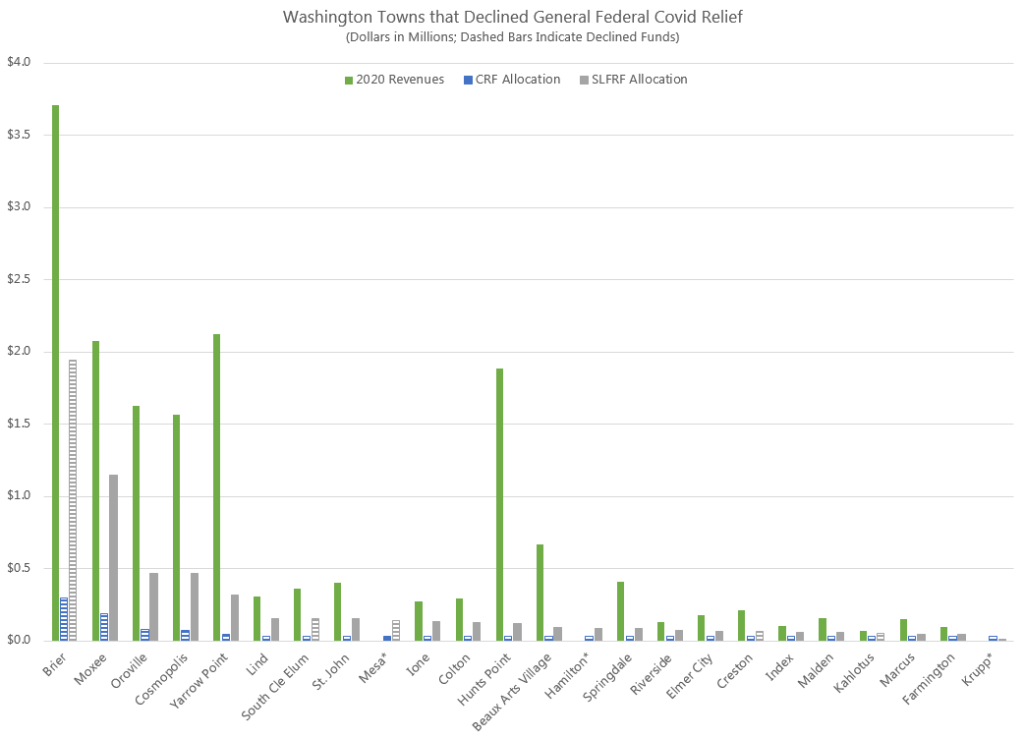11:51 am
April 27, 2022
Crosscut is running a nice series on the federal COVID relief money in Washington. An item from last month was about how six Washington cities did not claim their shares of the coronavirus state and local fiscal recovery fund (SLFRF).
Some of these small towns said they refused the money because they had not racked up any COVID-19 expenses or the necessary paperwork wasn’t worth the hassle for the funding.
But for two towns, the money — very much needed and wanted — went overlooked amidst a change in leadership in the town.
The six towns are Brier, South Cle Elum, Creston, Krupp, Mesa, and Kahlotus. According to the story, the mayors of Mesa and Kahlotus were “unaware” their cities didn’t claim the SLFRF money. No one from Krupp responded to Crosscut.
As we noted in our February policy brief on local government revenues in 2020, the SLFRF was part of the federal American Rescue Plan (ARP) Act (adopted in March 2021). The funds may be used generally for pandemic-related costs and to replace lost revenues. Cities and towns in Washington were allocated $1.213 billion from this fund. The total amount unclaimed by the six towns is $2.4 million.
But the SLFRF is not the only general COVID relief money that went to local governments. First, the federal Coronavirus Aid, Relief, and Economic Security (CARES) Act (adopted in March 2020) included the Coronavirus Relief Fund (CRF). The CRF may also be used for pandemic-related costs, but it cannot be used to replace revenue. Seattle was the only Washington city to receive a direct CRF allocation from the federal government, but the state of Washington chose to distribute $188.2 million of its share to other cities in the state.
According to the Department of Commerce, 12 towns declined their CRF allocations and another 11 never responded to Commerce’s attempts to send the money. The CRF amounts that never made it to towns in Washington totaled $1.2 million.
Five of the six towns that declined the SLFRF money either declined the CRF money (Brier, Creston) or did not respond to Commerce (Kahlotus, Krupp, South Cle Elum). Mesa accepted its share of the CRF ($30,000).
The chart shows the CRF and SLFRF allocations meant for the 24 towns that declined either or both of them. I’ve also included the towns’ 2020 revenues for context. (Krupp, Hamilton, and Mesa have not reported their 2020 financial data to the State Auditor’s Office. Their most recently reported revenues were: $30,660 for Krupp in 2017; $267,952 for Hamilton in 2018; and $273,655 for Mesa in 2019.)
These are such small towns that it is not too surprising they would decline either the SLFRF or the CRF money, which represent a huge influx compared to normal revenues and are accompanied by a high administrative burden. For 15 of the 24 towns, the combined allocations from the CRF and SLFRF are over half of a town’s 2020 revenues. For Kahlotus, the combined CRF and SLFRF allocation would have been $83,876, but the town’s revenues were just $66,590 in 2020.

Tags: ARP Act , CARES Act , COVID-19
